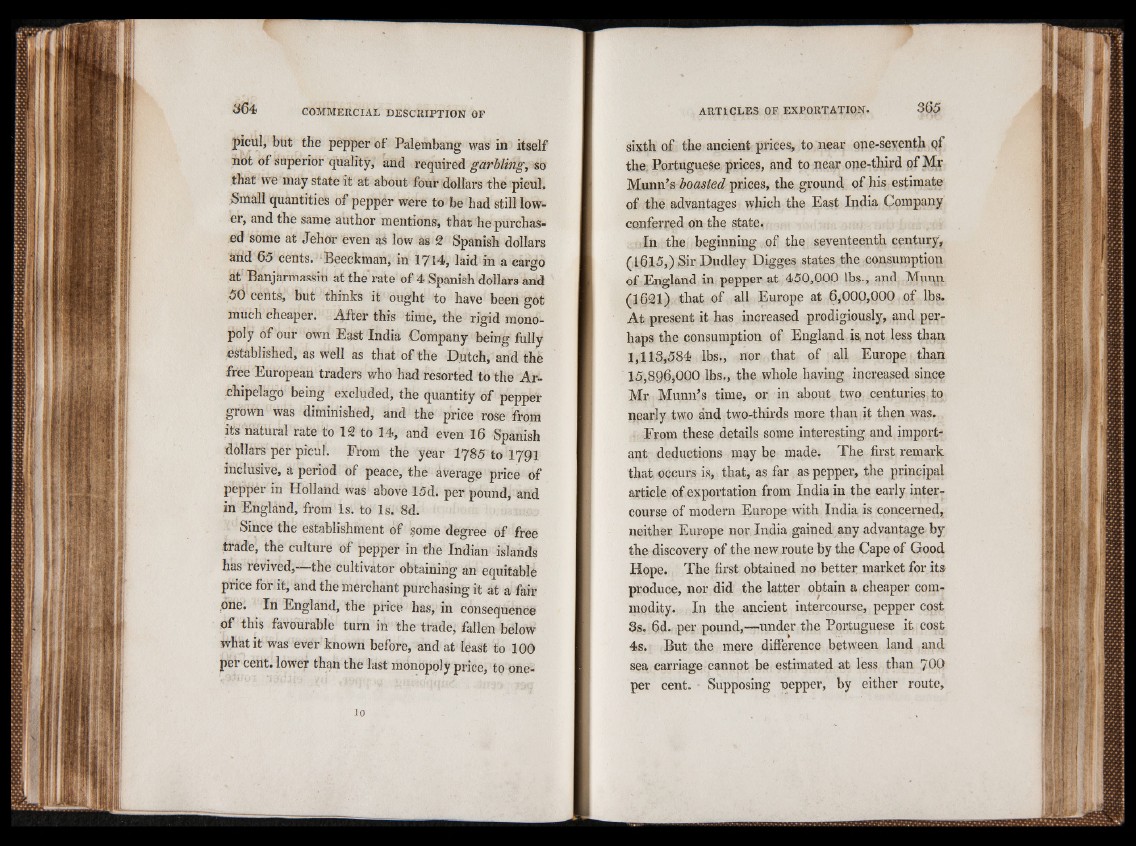
picul, but the pepper of Palembang was in itself
not of superior quality, and required garbling, so
,that we may state it at about four dollars the picul.
Small quantities of pepper were to be had still lower,
and the same author mentions, that he purchased
some at Jehor even as low as 2 Spanish dollars
arid 65 cents. Beeckman, in 1714, laid in a cargo
at Banjarmassin at the rate of 4 Spanish dollars and
56 cents, but thinks it ought to have been got
much cheaper. After this time, the rigid monopoly
of our own East India Company being fully
established, as well as that of the Dutch, and the
free European traders who had resorted to the Archipelago
being excluded, the quantity of pepper
grown was diminished, and the price rose from
its natural rate to 12 to 14, and even 16 Spanish
dollars per picul. From the year 1785 to 1791
inclusive, a period of peace, the average price of
pepper in Holland was above 15d. per pound, and
in England, from Is. to Is. 8d.
Since the establishment of some degree of free
trade, the culture of pepper in the Indian islands
has revived,- the cultivator obtaining an equitable
price for it, and the merchant purchasing it at a fair
one. In England, the price has, in consequence
of this favourable turn in the trade, fallen below
what it was ever known before, and at least to 100
per cent, lower than the last monopoly price, to onesixth
of the ancient prices, to near one-seventh qf
the Portuguese prices, and to near one-third of Mr
Munn’s boasted prices, the ground of his estimate
of the advantages which the East India Company
conferred on the state.
In the beginning of the seventeenth century,
(1615,) Sir Dudley Digges states the consumption
of England in pepper at 450,000 lbs., and Munn
(1621) that of all Europe at 6,000,000 of lbs.
At present it has increased prodigiously, and perhaps
the consumption of England is, not less than
1,113,584 lbs., nor that of all Europe than
15,896,000 lbs., the whole having increased since
Mr Munn’s time, or in about two centuries to
nearly two and two-thirds more than it then was.
From these details some interesting and important
deductions may be made. The first remark
that occurs is, that, as far as pepper, the principal
article of exportation from India in the early intercourse
of modern Europe with India is concerned,
neither Europe nor India gained any advantage by
the discovery of the new route by the Cape of Good
Hope. The first obtained no better market for its
produce, nor did the latter obtain a cheaper commodity.
In the ancient intercourse, pepper cost
Ss. 6d. per pound,—under the Portuguese it cost
4s. But the mere difference between land and
sea carriage cannot be estimated at less than 706
per cent. Supposing pepper, by either route,